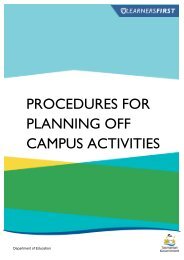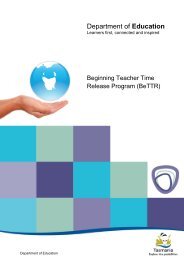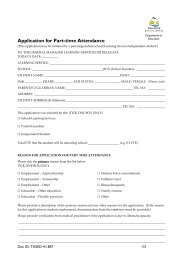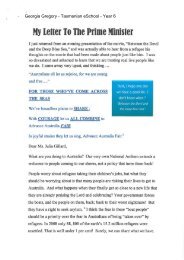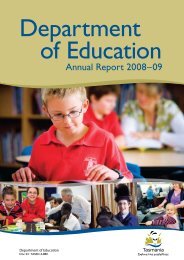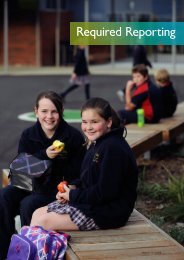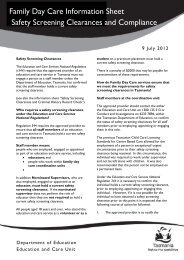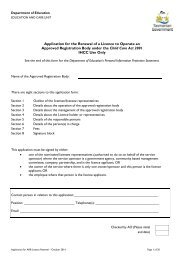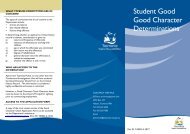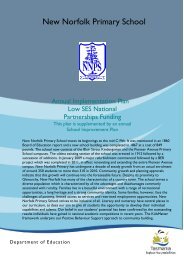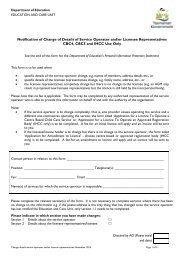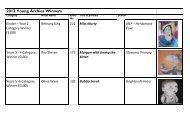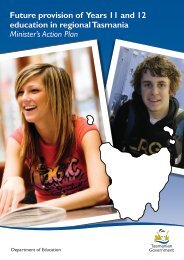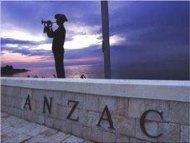Tas Curriculum K-10 - Languages - Italian - Department of Education
Tas Curriculum K-10 - Languages - Italian - Department of Education
Tas Curriculum K-10 - Languages - Italian - Department of Education
You also want an ePaper? Increase the reach of your titles
YUMPU automatically turns print PDFs into web optimized ePapers that Google loves.
Focus on:<br />
identity<br />
relationships<br />
belonging<br />
stereotypes<br />
• communities<br />
• youth culture<br />
• heroes<br />
• adapting known language<br />
Learning opportunities standard four<br />
• speaking and listening for particular purposes<br />
• a range <strong>of</strong> text types and media<br />
• expressing simple opinions<br />
• recognising and using familiar language patterns<br />
• personal and group identities<br />
• participation in local and global communities<br />
• using a variety <strong>of</strong> ICT tools to communicate<br />
interactions<br />
respect<br />
responsibility<br />
diversity<br />
Linguistic items<br />
Key concepts and topics<br />
• leisure / music<br />
• cooking / eating out<br />
• getting around<br />
Everyday language<br />
Exclamations e.g. Che peccato! davvero? non e’<br />
possible! allora, senti, mi dica, dimmi<br />
Beginning to converse within familiar contexts<br />
Intonation and Pronunciation<br />
Stress on final syllable when accented e.g. città,<br />
papa<br />
Pronunciation <strong>of</strong> ‘c’ and ‘g’ followed by vowels<br />
and use <strong>of</strong> ‘h’ ( hard and s<strong>of</strong>t sound) e.g. caffe’ /<br />
cinema, gondola / giocare, chi, ghiaccio<br />
Pronunciation <strong>of</strong> sc and followed by ‘h’ or ‘I’ / ’e’<br />
e.g. sci, schiavo<br />
Pronunciation <strong>of</strong> letter combinations ‘gli’ and ‘gn’<br />
Adjectives<br />
Agreement <strong>of</strong> number and gender with noun<br />
Common adjectives that precede the noun and<br />
their forms e.g. buon, buono, buon’, buona,<br />
buone, bel, bell’, bello, bella, bei, belle, begli<br />
environment<br />
lifestyle<br />
wellbeing<br />
sustainability<br />
• natural environment<br />
e.g. water,<br />
landscapes, regional<br />
areas<br />
• sport / health<br />
tradition<br />
celebration<br />
culture<br />
change<br />
• the Arts<br />
• performance e.g.<br />
plays, songs<br />
• fashion / clothing<br />
Possible teaching emphases<br />
• Have students listen to classmates’ descriptions<br />
and record responses e.g. listen to classmates<br />
describe their favourite leisure activities,<br />
record the findings and make a bar graph<br />
representing popularity.<br />
• Have students distinguish the difference<br />
between formal and informal register e.g. listen<br />
to two dialogues in the target language, one<br />
between adults, such as between a parent and<br />
teacher, and the other between a parent<br />
greeting a child on return from school;<br />
compare the differences.<br />
• Have students work in small groups to script<br />
and perform a role play e.g. in a restaurant<br />
• Remove key words from song lyrics and listen<br />
to songs to identify the missing words.<br />
• Have students write and perform in pairs a hiphop<br />
/ rap song in the target language on a topic<br />
<strong>of</strong> their choice.<br />
52




